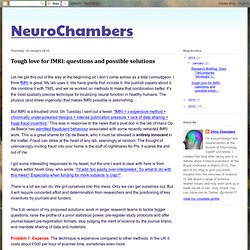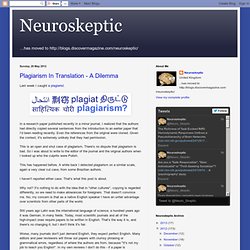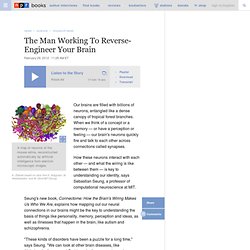

Linguistics. Tough love for fMRI: questions and possible solutions. Let me get this out of the way at the beginning so I don’t come across as a total curmudgeon.

I think fMRI is great. My lab uses it. We have grants that include it. We publish papers about it. We combine it with TMS, and we’ve worked on methods to make that combination better. There is a lot we can do. The tl;dr version of my proposed solutions: work in larger research teams to tackle bigger questions, raise the profile of a priori statistical power, pre-register study protocols and offer journal-based pre-registration formats, stop judging the merit of science by the journal brand, and mandate sharing of data and materials. Problem 1: Expense. Solution in brief: Work in larger research teams to divide the cost.
Solution in detail: It’s hard to make the technique cheaper. Solution in brief: Again, work in larger teams, combining data across centres to furnish large sample sizes. Problem 3: Researcher ‘degrees of freedom’. Problem 4: Pressure to publish. Glottopedia. Tarasoff v. Regents of the University of California. Tarasoff v.

Regents of the University of California, 17 Cal. 3d 425, 551 P.2d 334, 131 Cal. Rptr. 14 (Cal. 1976), was a case in which the Supreme Court of California held that mental health professionals have a duty to protect individuals who are being threatened with bodily harm by a patient. The original 1974 decision mandated warning the threatened individual, but a 1976 rehearing of the case by the California Supreme Court called for a "duty to protect" the intended victim. The professional may discharge the duty in several ways, including notifying police, warning the intended victim, and/or taking other reasonable steps to protect the threatened individual.
Facts[edit] Prosenjit Poddar was a student from Bengal, India.[1] He entered the University of California, Berkeley as a graduate student in September 1967 and resided at International House. After this rebuff, Poddar underwent a severe emotional crisis. During the summer of 1969, Tarasoff went to South America. References[edit] Illusion of control. The illusion of control is the tendency for people to overestimate their ability to control events, for instance to feel that they control outcomes that they demonstrably have no influence over.[1] The effect was named by psychologist Ellen Langer and has been replicated in many different contexts.[2] It is thought to influence gambling behavior and belief in the paranormal.[3] Along with illusory superiority and optimism bias, the illusion of control is one of the positive illusions.

Although, the idea of illusion of control has been studied prior to Langer. Psychological theorists have consistently emphasized the importance of perceptions of control over life events. One of the earliest instances of this is when Adler[who?] List of cognitive biases. Systematic patterns of deviation from norm or rationality in judgment Cognitive biases are systematic patterns of deviation from norm and/or rationality in judgment. They are often studied in psychology, sociology and behavioral economics.[1] Although the reality of most of these biases is confirmed by reproducible research,[2][3] there are often controversies about how to classify these biases or how to explain them.[4] Several theoretical causes are known for some cognitive biases, which provides a classification of biases by their common generative mechanism (such as noisy information-processing[5]).
Gerd Gigerenzer has criticized the framing of cognitive biases as errors in judgment, and favors interpreting them as arising from rational deviations from logical thought.[6] Explanations include information-processing rules (i.e., mental shortcuts), called heuristics, that the brain uses to produce decisions or judgments. Belief, decision-making and behavioral[edit] Social[edit] Neuroskeptic. Yet another "promising" novel antidepressant has failed to actually treat depression.

That's not an uncommon occurrence these days, but this time, the paper reporting the findings is almost as rubbish as the drug: Translational evaluation of JNJ-18038683, a 5-HT7 receptor antagonist, on REM sleep and in major depressive disorder So, Pharma giant Janssen invented JNJ-18038683. It's a selective antagonist at serotonin 5HT-7 receptors, making it pharmacologically rather unusual. Mind Hacks.
Sebastian Seung: A Neuroscientist Reverse-Engineering The Brain. Hide caption A map of neurons of the mouse retina, reconstructed automatically by artificial intelligence from electron microscopic images.

A. Zlateski based on data from K. Briggman, M. Helmstaedter, and W. Denk/MIT/Seung A map of neurons of the mouse retina, reconstructed automatically by artificial intelligence from electron microscopic images. Our brains are filled with billions of neurons, entangled like a dense canopy of tropical forest branches. How these neurons interact with each other — and what the wiring is like between them — is key to understanding our identity, says Sebastian Seung, a professor of computational neuroscience at MIT. Seung's new book, Connectome: How the Brain's Wiring Makes Us Who We Are, explains how mapping out our neural connections in our brains might be the key to understanding the basis of things like personality, memory, perception and ideas, as well as illnesses that happen in the brain, like autism and schizophrenia.
Interview Highlights. You Are Not So Smart.